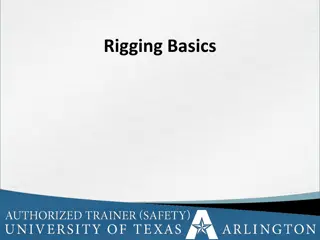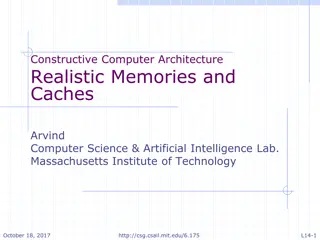Understanding Pipeline Hazards in Computer Architecture
Pipeline hazards in computer architecture are classified into three categories: structural, data, and control hazards. Structural hazards occur due to conflicts in hardware resources, data hazards stem from dependencies between instructions, and control hazards arise from branching instructions. These hazards can impact the performance of pipelined processors, leading to stall cycles and reduced efficiency. Solutions to structural hazards include pipeline stalling and the introduction of pipeline bubbles to ensure proper resource utilization and instruction execution.
Download Presentation

Please find below an Image/Link to download the presentation.
The content on the website is provided AS IS for your information and personal use only. It may not be sold, licensed, or shared on other websites without obtaining consent from the author. Download presentation by click this link. If you encounter any issues during the download, it is possible that the publisher has removed the file from their server.
E N D
Presentation Transcript
Pipeline Hazards There are situations, called hazards, thatprevent the next instruction in the instruction stream from executing during its designatedcycle There are three classes of hazards Structural hazard Data hazard Branch hazard Structural Hazards. They arise from resource conflicts when the hardware cannot support all possible combinations of instructions in simultaneous overlapped execution. Data Hazards. They arise when an instruction depends on the result of a previous instruction in a way that is exposed by the overlapping of instructions in the pipeline. Control Hazards.They arise from the pipelining of branches and other instructions that change the PC.
What Makes PipeliningHard? Power failing, Arithmetic overflow, I/O devicerequest, OS call, Page fault
PipelineHazards Structural hazard Resource conflicts when the hardware cannot support all possible combination of instructionssimultaneously Data hazard An instruction depends on the results of a previous instruction Branch hazard Instructions that change thePC
Structuralhazard Some pipeline processors have shared a single- memory pipeline for data andinstructions
Single Memory is a Structural Hazard Time (clock cycles) I n s t r. M M Reg U AL Reg Load Instr 1 M M Reg U AL Reg M M Reg U AL Reg Instr 2 O r d e M M Reg U AL Reg Instr 3 M M Reg U AL Reg Instr 4 rCan t read same memory twice in same clock cycle
Structuralhazard Memory data fetch requires on FI and FO S1 S2 S5 S3 S4 Fetch Instruction (FI) Decode Instruction (DI) Time 1 2 3 Fetch Operand (FO) Execution Instruction (EI) Write Operand (WO) S1 4 5 S2 1 2 3 4 5 S3 1 2 3 4 5 S4 1 2 3 4 5 S5 1 2 3 4 5
Structuralhazard To solve this hazard, we stall the pipeline until the resource is feed A stall is commonly called pipeline bubble, since it floats through the pipeline taking space but carry no useful work
Structural Hazards limit performance Example: if 1.3 memory accesses per instruction (30% of instructions execute loads and stores) and only one memory access per cycle then Average CPI Otherwise datapath resource is more than 100% utilized Structural Hazard Solution: Add more Hardware 1.3
Structural hazard Fetch Instruction (FI) Decode Instruction (DI) Time Fetch Operand (FO) Execution Instruction (EI) Write Operand (WO)
Data hazard Example: ADD SUB AND OR XOR R1R2+R3 R4R1-R5 R6R1 AND R7 R8R1 OR R9 R10R1 XOR R11
Datahazard FO: fetch data value WO: store the executedvalue S1 S2 S3 S4 S5 Fetch Instruction (FI) Decode Instruction (DI) Time Fetch Operand (FO) Execution Instruction (EI) Write Operand (WO)
Datahazard Delay load approach inserts a no-operation instruction to avoid the data conflict ADD No-op No-op SUB AND OR XOR R1 R2+R3 R4R1-R5 R6R1 AND R7 R8R1 OR R9 R10R1 XOR R11
Datahazard It can be further solved by a simple hardware technique called forwarding (also called bypassing or short-circuiting) The insight in forwarding is that the result is not really needed by SUB until the ADD executecompletely If the forwarding hardware detects that the previous ALU operation has written the register corresponding to a source for the current ALU operation, control logic selects the results in ALU instead of from memory
Data HazardClassification Three types of data hazards RAW : WAW : Write AfterWrite WAR : Write After Read Read After Write RAR : Read After Read Is this a hazard?
Read After Write(RAW) A read after write (RAW) data hazard refers to a situation where an instruction refers to a result that has not yet been calculated or retrieved. This can occur because even though an instruction is executed after a previous instruction, the previous instruction has processed through the pipeline. not been completely example: i1. i2. R2 <- R1 + R3 R2 + R3 R4 <-
Write After Read(WAR) Awrite after read (WAR) data hazard represents a problem with concurrent execution. For example: i1. i2. R4 <- R1 + R5 R5 <- R1 + R2
Write After Write(WAW) A write after write (WAW) data hazard may occur in a concurrent executionenvironment. example: i1. i2. R2 <- R4 + R7 R2 <- R1 + R3 We must delay the WB (Write Back) of i2 until the execution ofi1
Branch hazards Branch hazards can cause a greater performance loss for pipelines When a branch instruction is executed, it may or may not change thePC If a branch changes the PC to its target address, it is a taken branch Otherwise, it is untaken
Branchhazards There are FOUR schemes to handle branch hazards Freeze scheme Predict-untaken scheme Predict-taken scheme Delayed branch
5-StagePipelining Fetch Instruction (FI) Decode Instruction (DI) Time 1 2 3 Fetch Operand (FO) Execution Instruction (EI) Write Operand (WO) S1 4 5 S2 1 2 3 4 5 S3 1 2 3 4 5 S4 1 2 3 4 5 S5 1 2 3 4 5
BranchUntaken (Freezeapproach) The simplest method of dealing with branches is to redo the fetch followinga branch Fetch Instruction (FI) Decode Instruction (DI) Fetch Operand (FO) Execution Instruction (EI) Write Operand (WO)
BranchTaken (Freezeapproach) The simplest method of dealing with branches is to redo the fetch following abranch Fetch Instruction (FI) Decode Instruction (DI) Fetch Operand (FO) Execution Instruction (EI) Write Operand (WO)
BranchTaken (Freezeapproach) The simplest scheme to handle branches is to freeze the pipeline holding or deleting any instructions after the branch until the branch destination isknown The attractiveness of this solution liesprimarily in its simplicity both for hardware and software
BranchHazards (Predicted-untaken) A higher performance, and only slightly more complex, scheme is to treat every branch asnot taken It is implemented by continuing to fetch instructions as if the branch were normalinstruction The pipeline looks the same if the branch is not taken If the branch is taken, we need to redo the fetch instruction
BranchUntaken (Predicted-untaken) Fetch Instruction (FI) Decode Instruction (DI) Time Fetch Operand (FO) Execution Instruction (EI) Write Operand (WO)
BranchTaken (Predicted-untaken) Fetch Instruction (FI) Decode Instruction (DI) Fetch Operand (FO) Execution Instruction (EI) Write Operand (WO)
BranchTaken (Predicted-taken) An alternative scheme is to treat every branch as taken As soon as the branch is decoded and the target address is computed, we assume the branch to be taken and begin fetching and executing the target
BranchUntaken (Predicted-taken) Fetch Instruction (FI) Decode Instruction (DI) Fetch Operand (FO) Execution Instruction (EI) Write Operand (WO)
Branchtaken (Predicted-taken) Fetch Instruction (FI) Decode Instruction (DI) Fetch Operand (FO) Execution Instruction (EI) Write Operand (WO)
DelayedBranch Afourth scheme in use in some processors is called delayed branch It is done in compiler time. It modifies the code The general format is: branch instruction Delay slot branch target iftaken
DelayedBranch Optimal
Delayed Branch If the optimal isnot available: (b)Act like predict-taken (in complier way) (c)Act like predict-untaken (in complier way)
DelayedBranch Delayed Branch is limited by (1)the restrictions on the instructions that are scheduled into the delay slots (for example: another branch cannot bescheduled) (2)our ability to predict at compile time whether a branch is likely to be taken or not
Branch Prediction A pipeline with branch prediction uses some additional logic to guess the outcome of a conditional branch instruction before it isexecuted
BranchPrediction Various techniques can be used to predict whether a branch will be taken ornot: Prediction nevertaken Prediction alwaystaken Prediction byopcode Branch historytable The first three approaches are static: they do not depend on the execution history up to the time of the conditional branch instruction. The last approach is dynamic: they depend on the execution history.
Important Pipeline Characteristics Latency Time required for an instruction to propagate through thepipeline Based on the Number of Stages * Cycle Time Dominant if there are lots of exceptions / hazards, i.e. we have to constantly be re-filling thepipeline Throughput The rate at which instructions can start and finish Dominant if there are few exceptions and hazards, i.e. the pipeline stays mostlyfull Note we need an increased memory bandwidth over the non-pipelinedprocessor 58
Exceptions 59 An exception is when the normal execution order of instructions ischanged. names: Interrupt Fault Exception Examples: I/O device request Invoking OS service Page Fault Malfunction Undefinedinstruction Overflow/Arithmetic Anomaly Etc! This has many
Eliminating hazards- Pipeline bubbling Bubbling the p ip e line , also knownas a p ipe line b re a k or a p ipe line s ta ll, is amethod for preventing data, structural, and branch hazards fromoccurring. instructions are fetched, control logic determines whether a hazard could/will occur . If this is true, then the control logic inserts NOPs into the pipeline. Thus, before the next instruction (which would cause the hazard) is executed, the previous one will have had sufficient time to complete and prevent the hazard.
No: of NOPs = stages inpipeline If the number of NOPs is equal to the number of stages in the pipeline, the processor has been cleared of all instructions and can proceed free from hazards. All forms of stalling introduce a delay before the processor can resume execution.























